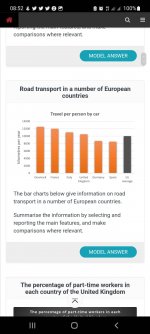hardyweineberg
Member
- Joined
- Jun 3, 2022
- Member Type
- Student or Learner
- Native Language
- Igbo
- Home Country
- Nigeria
- Current Location
- Nigeria
I wrote this essay. Please, answer my few questions below.
The bar chart provides data about road transport in some European countries.
Overall, it is clear that transport by road is most common in Denmark and least common in Spain. While the figures for Germany and Spain are lower than the European average, those for the other countries are higher.
In Europe, road vehicles travel 10,000 kilometres each year on average. Regarding Denmark, France, Italy, and the UK, road vehicles in Denmark cover over 12,000 kilometres each year, and this is the highest figure, followed by France's 12,000 and Italy's figure of over 10,000. Lastly, people in the UK travel just over 10,000 kilometres per year, which, although lower than the distances covered in Denmark, France, and Italy, is higher than the EU average.
Distances covered by road vehicles per year in Germany (above 80,000) and in Spain (over 80,000) are considerably lower than the EU average. It is worth noting that Germany's figure is only negligibly higher than Spain's, the lowest.
"While the figures for Germany and Spain are lower than the European average, those for the other countries are higher."
1) Is it okay to omit "than the European average"?
"people in the UK travel just over 10,000 kilometres per year, which, although lower than the distances covered in Denmark, France, and Italy, is higher than the EU average."
2) Is this sentence grammatical?
"Distances covered by road vehicles per year in Germany (above 80,000) and in Spain (over 80,000) are considerably lower than the EU average."
3) Is my use of brackets grammatical, clear, and acceptable?
4) Is it correct to say "distances covered by"?
The bar chart provides data about road transport in some European countries.
Overall, it is clear that transport by road is most common in Denmark and least common in Spain. While the figures for Germany and Spain are lower than the European average, those for the other countries are higher.
In Europe, road vehicles travel 10,000 kilometres each year on average. Regarding Denmark, France, Italy, and the UK, road vehicles in Denmark cover over 12,000 kilometres each year, and this is the highest figure, followed by France's 12,000 and Italy's figure of over 10,000. Lastly, people in the UK travel just over 10,000 kilometres per year, which, although lower than the distances covered in Denmark, France, and Italy, is higher than the EU average.
Distances covered by road vehicles per year in Germany (above 80,000) and in Spain (over 80,000) are considerably lower than the EU average. It is worth noting that Germany's figure is only negligibly higher than Spain's, the lowest.
"While the figures for Germany and Spain are lower than the European average, those for the other countries are higher."
1) Is it okay to omit "than the European average"?
"people in the UK travel just over 10,000 kilometres per year, which, although lower than the distances covered in Denmark, France, and Italy, is higher than the EU average."
2) Is this sentence grammatical?
"Distances covered by road vehicles per year in Germany (above 80,000) and in Spain (over 80,000) are considerably lower than the EU average."
3) Is my use of brackets grammatical, clear, and acceptable?
4) Is it correct to say "distances covered by"?
